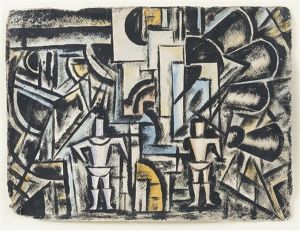Vera Mikhailovna Ermolaeva Paintings
Vera Mikhailovna Ermolaeva was a Russian avant-garde artist, painter, graphic designer, and art educator. Born on June 15, 1893, in the city of Lubny, then part of the Russian Empire (now Ukraine), Ermolaeva became an active participant in the vibrant and transformative art scene of early 20th-century Russia.
In the 1910s, Ermolaeva moved to Saint Petersburg (later known as Petrograd and then Leningrad) to pursue her artistic education, enrolling at the State Free Art Educational Studios (the former Higher Art School of Painting, Sculpture and Architecture) where she studied under prominent artists of the time. She became deeply involved with avant-garde circles, and her work was influenced by the radical ideas and artistic experiments that characterized the period.
Ermolaeva became associated with the movement of Suprematism, founded by Kazimir Malevich, and she was one of the artists to sign the manifesto of UNOVIS, a group of avant-garde artists led by Malevich who sought to develop and promote Suprematist art. Her work from this period shows a strong commitment to abstract compositions, focusing on the basic geometric forms and a limited color palette that were central to Suprematist philosophy.
As an educator, Ermolaeva taught at the Vitebsk Art School, which was a hub for avant-garde art and education. There, she worked alongside other prominent artists such as Marc Chagall and El Lissitzky. She later became the director of the school after Chagall's departure. Her approach to teaching was innovative, emphasizing creative freedom and the importance of abstract principles in art.
Ermolaeva's career was abruptly interrupted by the political turmoil and purges of Joseph Stalin's regime. Despite her contributions to Russian art and education, she became a victim of the Great Purge. She was arrested by the NKVD (the Soviet secret police) and, after a closed trial, was executed in 1937.
The tragic end to Ermolaeva's life led to her being largely forgotten for many years, and it was only after the Soviet Union's dissolution that her work and significant role in the Russian avant-garde movement began to be reassessed and appreciated. Today, Vera Ermolaeva is recognized for her contributions to modern art, and her works can be found in the collections of various museums and galleries dedicated to avant-garde art.

